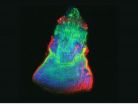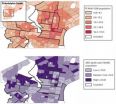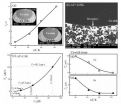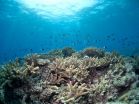(Press-News.org) KANSAS CITY, MO - As multicellular creatures go, planaria worms are hardly glamorous. To say they appear rudimentary is more like it. These tiny aquatic flatworms that troll ponds and standing water resemble brown tubes equipped with just the basics: a pair of beady light-sensing "eyespots" on their head and a feeding tube called the pharynx (which doubles as the excretory tract) that protrudes from a belly sac to suck up food. It's hard to feel kinship with them.
But admiration is another thing, because many planaria species regenerate in wondrous ways—namely, when quartered they reconstruct themselves from the pieces. Sliced through the "waist", they regenerate the missing tail or head; bisected lengthwise, worms duplicate their mirror image. This capacity is not what's surprising, as biologists know that 30% of their body cells are stem cells. The question is, how do stem cells in a planaria fragment know how to generate what's missing?
In the April 15, 2014 issue of the online journal eLife, Stowers Institute for Medical Research Investigator Alejandro Sánchez Alvarado and colleagues address that issue by identifying genes worms use to rebuild an amputated pharynx. They report that near the top of the pharynx regeneration hierarchy is a master regulator called FoxA. These findings support an evolutionarily conserved role for FoxA proteins in driving construction of endoderm-derived organs and reveal how stem cells sense loss of a particular structure on a molecular level.
Mammals can deploy adult stem cells to replace skin or immune system cells, among others. But when it comes to re-creating entire structures, amphibian, fish and planarian species are the champs. "When mammals are severely injured, they just heal the wound and call it a day," says Sánchez Alvarado, who is also a Howard Hughes Medical Institute Investigator. "But if a salamander loses a limb, it will first heal the wound and then start assembling the missing parts. Right now, the mechanisms cells use to realize what structure is missing and then restore it remain completely mysterious."
To unravel the mystery, the team conducted two "screens". First, they amputated the worm pharynx, which prohibits feeding for about a week as planaria rebuild a new one. Around day 3 post-amputation, the team conducted microarray analysis to identify any gene switched on by amputation and amassed about 350 candidates. To test them, they then fed inhibitory RNAs designed to suppress expression of each gene separately to new batches of worms, repeated the amputations and observed whether worms regained feeding ability. That narrowed the list to 20 candidates that when lost hampered feeding and in most cases interfered with pharynx formation.
According to Carrie Adler, Ph.D., a postdoctoral fellow in the Sánchez Alvarado lab who led the study, analysis showed most of the 20 factors either had a generic function in stem cells (which was interesting but not what they were after) or were specifically required for pharynx regeneration. Among the latter, one factor showing a particularly robust effect was a DNA-binding protein called FoxA. "Targeting FoxA completely blocked pharynx regeneration but had no effect on the regeneration of other organs," says Adler.
High resolution microscopy analysis showed that stem cells ramped up FoxA expression soon after they converged on the amputation site. "Currently, we think that FoxA triggers a cascade of gene expression that drives stem cells to produce all of the different cells of the pharynx, including muscle, neurons, and epithelial cells," says Adler. "The next question is how FoxA gets stimulated in the first place in only some stem cells."
Researchers knew previously that during embryogenesis FoxA initiates formation of endoderm-derived organs in species as diverse as mouse and roundworms. The new work suggests that regenerating tissues exploit those evolutionarily ancient gene expression pathways. "Engulfing food is one thing that defines an animal," says Sánchez Alvarado. "This means that organisms from humans to flatworms use a common toolbox to build a digestive system, one that has been shared since animals became multicellular."
A fortuitous (in hindsight) setback facilitated the work. As a graduate student studying the roundworm C. elegans, Adler decided to test effects of roundworm anesthetics on flatworms. One, a sodium azide bath, put planaria to sleep but made their pharynxes drop off. Aghast, Adler soon realized that the azide solution (which planaria survived) left a uniform, minimally-destructive lesion. Thus was born the "selective chemical amputation method", allowing large-scale analysis and reliable quantification of results and freeing researchers from tedious hours at a dissecting microscope.
But why go to such trouble to pioneer regeneration research in small animal models? The answer is obvious to both Adler and Sánchez Alvarado. "Because regeneration is limited and difficult to study in humans and mice," Adler says. "Planaria have infinite capacity to regrow all organs. By understanding this enhanced ability we may learn how to accelerate mammalian regeneration."
Sánchez Alvarado concludes that the work cements planaria's place as a tractable model system to analyze regeneration or stem cell activity. "Planaria's simplicity is what makes it such a fruitful system to answer questions relevant to regeneration," he says. "If we used salamanders for these studies it would take 90 days to do an experiment. I want answers to these questions yesterday, not years from now."
INFORMATION:
Also contributing to the all-Stowers study were Genomics Scientist Chris Seidel, Ph.D., and Sean McKinney, Ph.D., of the Microscopy Center.
The Stowers Institute for Medical Research, the National Institutes of Health, and the Howard Hughes Medical Institute funded the study.
About the Stowers Institute for Medical Research
The Stowers Institute for Medical Research is a non-profit, basic biomedical research organization dedicated to improving human health by studying the fundamental processes of life. Jim Stowers, founder of American Century Investments, and his wife, Virginia, opened the Institute in 2000. Since then, the Institute has spent over 900 million dollars in pursuit of its mission.
Currently, the Institute is home to nearly 550 researchers and support personnel; over 20 independent research programs; and more than a dozen technology-development and core facilities.
Planaria deploy an ancient gene expression program in the course of organ regeneration
Stowers team develops novel assay to identify genes controlling pharynx regeneration in flatworms
2014-04-10
ELSE PRESS RELEASES FROM THIS DATE:
Scarless wound healing -- applying lessons learned from fetal stem cells
2014-04-10
New Rochelle, NY, April 10, 2014—In early fetal development, skin wounds undergo regeneration and healing without scar formation. This mechanism of wound healing later disappears, but by studying the fetal stem cells capable of this scarless wound healing, researchers may be able to apply these mechanisms to develop cell-based approaches able to minimize scarring in adult wounds, as described in a Critical Review article published in Advances in Wound Care, a monthly publication from Mary Ann Liebert, Inc., publishers and an Official Journal of the Wound Healing Society. ...
Therapeutic options and bladder-preserving strategies in bladder cancer
2014-04-10
New Rochelle, NY, April 10, 2014—Men are three to four times more likely to get bladder cancer than women. The possible causes for this greater risk among men, the importance of early and accurate diagnosis, and the scope of available and emerging surgical, chemotherapeutic, and immunotherapeutic approaches for treating bladder cancer in men are the focus of a comprehensive Review article in Journal of Men's Health, a peer-reviewed publication from Mary Ann Liebert, Inc., publishers. The article is available free on the Journal of Men's Health website.
Coauthors R. ...
Camels emit less methane than cows or sheep
2014-04-10
Ruminant cows and sheep account for a major proportion of the methane produced around the world. Currently around 20 percent of global methane emissions stem from ruminants. In the atmosphere methane contributes to the greenhouse effect – that's why researchers are looking for ways of reducing methane production by ruminants. Comparatively little is known about the methane production of other animal species – but one thing seems to be clear: Ruminants produce more of the gas per amount of converted feed than other herbivores.
The only other animal group that regularly ...
Neurofinance study confirms that financial decisions are made on an emotional basis
2014-04-10
The willingness of decision makers to take risks increases when they play games of chance with money won earlier. Risk taking also rises when they have the opportunity to compensate for earlier losses by breaking even. This outcome was demonstrated by Dr. Kaisa Hytönen, a Finnish Aalto University researcher in neurofinance, together with her international colleagues.
There are frequently various linkages between financial decisions: the circumstances accompanying the decision are rarely completely independent of each other. Both profits and losses, for example, on the ...
HIV battle must focus on hard-hit streets, paper argues
2014-04-10
PROVIDENCE, R.I. [Brown University] — In U.S. cities, it's not just what you do, but also your address that can determine whether you will get HIV and whether you will survive. A new paper in the American Journal of Public Health illustrates the effects of that geographic disparity – which tracks closely with race and poverty – and calls for an increase in geographically targeted prevention and treatment efforts.
"People of color are disproportionately impacted, and their risk of infection is a function not just of behavior but of where they live and the testing and treatment ...
Obsessive-compulsive disorder may reflect a propensity for bad habits
2014-04-10
Philadelphia, PA, April 10, 2014 – Two new studies published this week in Biological Psychiatry shed light on the propensity for habit formation in obsessive-compulsive disorder (OCD). These studies suggest that a tendency to develop habits, i.e., the compulsive component of the disorder, may be a core feature of the disorder rather than a consequence of irrational beliefs. In other words, instead of washing one's hands because of the belief that they are contaminated, some people may develop concerns about hand contamination as a consequence of a recurring urge to wash ...
Solute redistribution profiles during rapid solidification of undercooled ternary Co-Cu-Pb alloy
2014-04-10
Researchers at the Department of Applied Physics, Northwestern Polytechnical University, in Xi'an, China, are engaged in revealing the mysteries of solidification process and the development of new materials using self-designed experimental instrument which can simulate the space environment such as containerless state. Solidification mechanism is of great importance to better understand the relationship between solidification process and microstructure evolution, so that we can follow them to design and prepare new materials which can meet the application requirements.
Dr. ...
New report provides solution to NEET challenge in UK and abroad
2014-04-10
A NEW strategy to help young people find jobs that pay fair wages, accompanied by high quality training and better career opportunities, has been developed by a University of Huddersfield professor. Outlined in a specially-commissioned research report, it is beginning to catch the attention of policy-makers throughout the UK.
After conducting years of funded research into the challenges that face young people dubbed NEET – meaning that they are not in employment, education or training – Professor Robin Simmons has devised the concept of a Youth Resolution designed to ...
Researchers show fruit flies have latent bioluminescence
2014-04-10
WORCESTER, Mass. – New research from scientists at the University of Massachusetts Medical School shows that fruit flies are secretly harboring the biochemistry needed to glow in the dark —otherwise known as bioluminescence.
The key to activating this latent ability is a novel synthetic analog of D-luciferin developed at UMMS. The findings, published in the journal Proceedings of the National Academy of Sciences, suggest that the inherent biochemistry needed for bioluminescence is more common than previously thought. Synthetic luciferins can unmask latent enzymatic ...
Coral reefs of the Mozambique Channel a leading candidate for saving marine diversity
2014-04-10
Marine scientists keen on finding patterns of coral decline and persistence in gradually warming oceans have a complex challenge: how to save reefs containing the most diversity with limited resources. In the Western Indian Ocean, researchers from the Wildlife Conservation Society, the University of Warwick, the ARC Centre for Excellence of Coral Reef Studies, Simon Fraser University, University of North Carolina at Chapel Hill, and other groups have found that the corals of the Mozambique Channel should be a priority for protection as climate change continues to threaten ...
LAST 30 PRESS RELEASES:
School feeding programs lead to modest but meaningful results
Researchers develop AI Tool to identify undiagnosed Alzheimer's cases while reducing disparities
Seaweed based carbon catalyst offers metal free solution for removing antibiotics from water
Simple organic additive supercharges UV treatment of “forever chemical” PFOA
£13m NHS bill for ‘mismanagement’ of menstrual bleeds
The Lancet Psychiatry: Slow tapering plus therapy most effective strategy for stopping antidepressants, finds major meta-analysis
Body image issues in adolescence linked to depression in adulthood
Child sexual exploitation and abuse online surges amid rapid tech change; new tool for preventing abuse unveiled for path forward
Dragon-slaying saints performed green-fingered medieval miracles, new study reveals
New research identifies shared genetic factors between addiction and educational attainment
Epilepsy can lead to earlier deaths in people with intellectual disabilities, study shows
Global study suggests the underlying problems of ECT patients are often ignored
Mapping ‘dark’ regions of the genome illuminates how cells respond to their environment
ECOG-ACRIN and Caris Life Sciences unveil first findings from a multi-year collaboration to advance AI-powered multimodal tools for breast cancer recurrence risk stratification
Satellite data helps UNM researchers map massive rupture of 2025 Myanmar earthquake
Twisting Spins: Florida State University researchers explore chemical boundaries to create new magnetic material
Mayo Clinic researchers find new hope for toughest myeloma through off-the-shelf immunotherapy
Cell-free DNA Could Detect Adverse Events from Immunotherapy
American College of Cardiology announces Fuster Prevention Forum
AAN issues new guideline for the management of functional seizures
Could GLP-1 drugs affect risk of epilepsy for people with diabetes?
New circoviruses discovered in pilot whales and orcas from the North Atlantic
Study finds increase in risk of binge drinking among 12th graders who use 2 or more cannabis products
New paper-based technology could transform cancer drug testing
Opioids: clarifying the concept of safe supply to save lives
New species of tiny pumpkin toadlet discovered in Brazil highlights need for conservation in the mountain forests of Serra do Quiriri
Reciprocity matters--people were more supportive of climate policies in their country if they believed other countries were making significant efforts themselves
Stanford Medicine study shows why mRNA-based COVID-19 vaccines can cause myocarditis
Biobanking opens new windows into human evolution
Sky-high smoke
[Press-News.org] Planaria deploy an ancient gene expression program in the course of organ regenerationStowers team develops novel assay to identify genes controlling pharynx regeneration in flatworms






